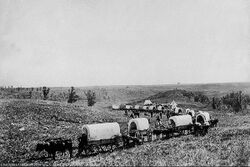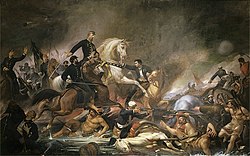General Insurrection of 1859: Difference between revisions
m (→Background) |
mNo edit summary |
||
| (One intermediate revision by the same user not shown) | |||
| Line 18: | Line 18: | ||
}} | }} | ||
The '''General Insurrection''' was a major army mutiny that took place in [[Trellin]] in 1859. The major centres of rebellion were in the south of the empire, originating in Taramë in response to endemic corruption in both the military and civil service. As garrisons from [[Bal Emrith]] to [[ | The '''General Insurrection''' was a major army mutiny that took place in [[Trellin]] in 1859. The major centres of rebellion were in the south of the empire, originating in Taramë in response to endemic corruption in both the military and civil service. As garrisons from [[Bal Emrith]] to [[Mëhidan]] rose in rebellion, Kevlfir Mahalam was put in command of three northern armies and tasked with restoring order. There were few major engagements, as both commanders and soldiers were reluctant to engage their former comrades. | ||
==Background== | ==Background== | ||
[[File:Khataxi wagons.jpg|thumb|left|250px|A colonial {{wp|wagon train}} from the Great Khataxan Settlement, c. 1792]] | [[File:Khataxi wagons.jpg|thumb|left|250px|A colonial {{wp|wagon train}} from the Great Khataxan Settlement, c. 1792]] | ||
During the late eighteenth century, under the colonial-minded governments of [[House Palægos]], Trellin's holdings south of the [[Sea of Velar]] extended rapidly inland. Treaties with [[Azmir]] and [[Txekrikar]], among others, opened up large areas formerly deemed ''{{wp|terra nullius}}'' for Trellinese settlement, and edicts by [[Azara IV]] and [[Tovelindra III]] encouraged colonists to purchase large areas of relatively poor land for low prices per acre. Tens of thousands migrated between 1784 and 1811, and the rate rapidly increased with the discovery of gold and silver in rivers and mountains in [[Rezat]] and [[Khatax]]. The city of [[Halith]], home to 600 in 1850, grew to a population of 100,000 by the end of the decade, and many coastal cities were inundated with immigrant workers from across the empire and overseas. | During the late eighteenth century, under the colonial-minded governments of [[House Palægos]], Trellin's holdings south of the [[Sea of Velar]] extended rapidly inland. Treaties with [[Azmir]] and [[Txekrikar]], among others, opened up large areas formerly deemed ''{{wp|terra nullius}}'' for Trellinese settlement, and edicts by [[Azara IV]] and [[Tovelindra III]] encouraged colonists to purchase large areas of relatively poor land for low prices per acre. Tens of thousands migrated between 1784 and 1811, and the rate rapidly increased with the discovery of gold and silver in rivers and mountains in [[Rezat]] and [[Khatax]] in the mid-nineteenth century. The city of [[Old Halith|Halith]], home to 600 in 1850, grew to a population of 100,000 by the end of the decade, and many coastal cities were inundated with immigrant workers from across the empire and overseas. | ||
With such a rapidly growing population, crime rates in the southern provinces soared. At the same time, conflict over land saw bloodshed, especially among ranchers. Recruitment drives attempted to bolster the numbers of police in the colonial territories, but repeated outbreaks of violence and drunken brawls - one of which, in 1851, killed over two hundred in Pataxi - eventually compelled the imperial office for colonial administration to seek a military presence. Soldiers stationed in 'trouble spots' received substantial bonuses over the counterparts elsewhere, making such positions highly sought after. By 1853 it was common for soldiers to give a bribe to secure a more lucrative posting. Corruption began to move up the chain of command and entered the civil service, as it was considered easier for a career to advance in the "new" provinces than in the older territories of the empire. "It became virtually impossible to achieve any official posting without paying up to a year's salary in bribes," wrote civil war historian Timiet Nata'an, and this situation became increasingly frustrating to mid-level officers and many in the civil service.<ref>Nata'an, Timiet, "Corruption and the Trellinese rebellions" in ''Journal of Trellinese Colonial History'' (Vol. 14, No. 55, 1989), pp. 69-70.</ref> | With such a rapidly growing population, crime rates in the southern provinces soared. At the same time, conflict over land saw bloodshed, especially among ranchers. Recruitment drives attempted to bolster the numbers of police in the colonial territories, but repeated outbreaks of violence and drunken brawls - one of which, in 1851, killed over two hundred in Pataxi - eventually compelled the imperial office for colonial administration to seek a military presence. Soldiers stationed in 'trouble spots' received substantial bonuses over the counterparts elsewhere, making such positions highly sought after. By 1853 it was common for soldiers to give a bribe to secure a more lucrative posting. Corruption began to move up the chain of command and entered the civil service, as it was considered easier for a career to advance in the "new" provinces than in the older territories of the empire. "It became virtually impossible to achieve any official posting without paying up to a year's salary in bribes," wrote civil war historian Timiet Nata'an, and this situation became increasingly frustrating to mid-level officers and many in the civil service.<ref>Nata'an, Timiet, "Corruption and the Trellinese rebellions" in ''Journal of Trellinese Colonial History'' (Vol. 14, No. 55, 1989), pp. 69-70.</ref> | ||
Latest revision as of 18:16, 5 February 2023
| General Insurrection | |||||
|---|---|---|---|---|---|
 | |||||
| |||||
| Belligerents | |||||
|
| Trellinese army mutineers | ||||
| Commanders and leaders | |||||
|
| Garaus Khezri | ||||
The General Insurrection was a major army mutiny that took place in Trellin in 1859. The major centres of rebellion were in the south of the empire, originating in Taramë in response to endemic corruption in both the military and civil service. As garrisons from Bal Emrith to Mëhidan rose in rebellion, Kevlfir Mahalam was put in command of three northern armies and tasked with restoring order. There were few major engagements, as both commanders and soldiers were reluctant to engage their former comrades.
Background

During the late eighteenth century, under the colonial-minded governments of House Palægos, Trellin's holdings south of the Sea of Velar extended rapidly inland. Treaties with Azmir and Txekrikar, among others, opened up large areas formerly deemed terra nullius for Trellinese settlement, and edicts by Azara IV and Tovelindra III encouraged colonists to purchase large areas of relatively poor land for low prices per acre. Tens of thousands migrated between 1784 and 1811, and the rate rapidly increased with the discovery of gold and silver in rivers and mountains in Rezat and Khatax in the mid-nineteenth century. The city of Halith, home to 600 in 1850, grew to a population of 100,000 by the end of the decade, and many coastal cities were inundated with immigrant workers from across the empire and overseas.
With such a rapidly growing population, crime rates in the southern provinces soared. At the same time, conflict over land saw bloodshed, especially among ranchers. Recruitment drives attempted to bolster the numbers of police in the colonial territories, but repeated outbreaks of violence and drunken brawls - one of which, in 1851, killed over two hundred in Pataxi - eventually compelled the imperial office for colonial administration to seek a military presence. Soldiers stationed in 'trouble spots' received substantial bonuses over the counterparts elsewhere, making such positions highly sought after. By 1853 it was common for soldiers to give a bribe to secure a more lucrative posting. Corruption began to move up the chain of command and entered the civil service, as it was considered easier for a career to advance in the "new" provinces than in the older territories of the empire. "It became virtually impossible to achieve any official posting without paying up to a year's salary in bribes," wrote civil war historian Timiet Nata'an, and this situation became increasingly frustrating to mid-level officers and many in the civil service.[1]
For many who were now stationed inland, the dry climate and poor living conditions were an unwelcome change from their former coastal postings. A lack of funding led to rising discontent, and provisioning convoys were often late to the more remote garrisons. Their commanding officers regularly protested to their superiors but found it difficult to provoke any improvement without bribery.
Outbreak
In November 1858, after a mutiny near Izarga, a group of Emritian officers approached Brigadier Garaus Khezri and asked him to take command of the provincial army. Khezri had been the most popular candidate for that posting the year prior but was passed over in favour of Matxü Tamolka, who was widely known to have given a substantial bribe to the provincial governor. He declined, but assured them he would continue to campaign against the endemic graft. That same month he received a formal reprimand from Tamolka for giving a public address in Taramë, the provincial capital, against corruption.
Escalating sequence of events.
Towards the end of January, the position of commander of the Mevirese army became vacant, and Khezri submitted an application for the post. Instead, on 8 February, he received a new posting to Ternos which came with a decrease in pay and little prospect of promotion. On receiving his orders, Khezri approached his commanding officer "and struck him as firm a blow as any the brigadier had yet landed on a foe."[2]
Progression
Aftermath
In the wake of the rebellion, discontent continued to fester across the military and throughout the south. The rebel-civilian collaboration during the General Insurrection laid the groundwork for a more general rebellion during the Trellinese Civil War of the 1890s.
References
- ↑ Nata'an, Timiet, "Corruption and the Trellinese rebellions" in Journal of Trellinese Colonial History (Vol. 14, No. 55, 1989), pp. 69-70.
- ↑ Fari, Kosatis, Letters from the Rising: a collection of missives from the author chronicling the events of our recent General Insurrection (Durats, 1866), p. 47.





